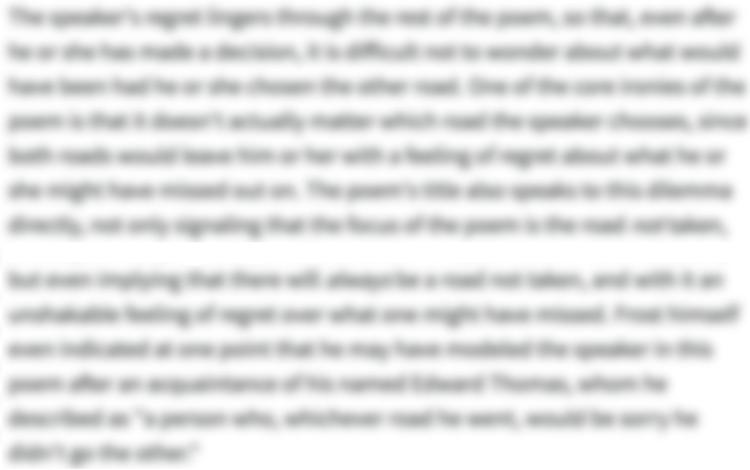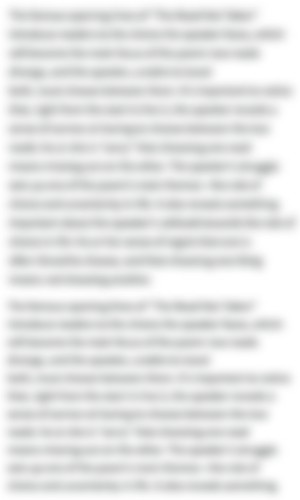The Full Text of “Sonnet 138: When my love swears that she is made of truth”
1When my love swears that she is made of truth,
2I do believe her, though I know she lies,
3That she might think me some untutored youth,
4Unlearnèd in the world’s false subtleties.
5Thus vainly thinking that she thinks me young,
6Although she knows my days are past the best,
7Simply I credit her false-speaking tongue:
8On both sides thus is simple truth suppressed.
9But wherefore says she not she is unjust?
10And wherefore say not I that I am old?
11Oh, love’s best habit is in seeming trust,
12And age in love loves not to have years told.
13 Therefore I lie with her and she with me,
14 And in our faults by lies we flattered be.
-
“Sonnet 138: When my love swears that she is made of truth” Introduction
-
"Sonnet 138" was written by the English poet and playwright William Shakespeare. The poem was probably written in the early 1590s—though it wasn't published until 1599, when it appeared in a pirated edition of Shakespearean poems, The Passionate Pilgrim. (It was later published in the 1609 edition of Shakespeare's Sonnets.) The poem dives into a difficult, complicated relationship. Both the speaker and the woman he loves lie to each other constantly—about small things, like the speaker's age, and bigger things, like whether his mistress is cheating on him. The two lovers end up in a paradoxical situation: they take comfort—at least, they try to take comfort—in each other's lies, instead of the love they feel for each other.
-
-
“Sonnet 138: When my love swears that she is made of truth” Summary
-
When the woman I love swears that she is honest, I believe her, even though I know she's lying to me. I do this so that she will think that I am a naïve young person, unexperienced in the ways of the world. In this way, I pretend that she thinks I’m young—even though she knows I’m getting on in years. And I pretend to believe her lies. In this way, neither side is truthful. But why doesn’t she admit that she lies? And why don’t I admit that I’m old? Because the best thing about love is pretending to trust one another—and because old people don’t like to have their age revealed to their lovers. Therefore I lie to her and she lies to me; as a result, despite our faults, these lies make us feel better.
-
-
“Sonnet 138: When my love swears that she is made of truth” Themes
-
Truth, Lies, and Love
“Sonnet 138” plunges its reader into a complicated and fraught relationship. The poem’s speaker and the woman he loves both lie to each other constantly about matters large and small: for instance, the speaker’s age and his mistress’s unfaithfulness. As a result, the speaker feels deeply insecure and unsettled—unable to trust the person he loves and, indeed, unable to place his trust in love itself. For the speaker of the poem, love is thus not a source of comfort and joy. Instead, he argues, with considerable cynicism and bitterness, the only comfort that his relationship affords is the uncertain and perilous pleasure of mutual deception.
Both the speaker and the woman he loves are habitually untruthful to each other. The poem opens with one such lie. Although the speaker’s “love swears that she is made of truth,” the speaker “know[s] she lies.” In other words, the speaker’s mistress has been unfaithful to him (wildly so, as Shakespeare notes in "Sonnet 135"!). And the speaker knows it: he doesn’t have any illusions about his mistress’s faithfulness. However, he insists—paradoxically—“I do believe her, though I know she lies.” Basically, he doesn’t actually believe his mistress—but he acts like he does.
He does so for a key reason: it makes him seem naïve—and thus younger than he actually he is. He wants to seem like “some untutored youth.” This is hardly a convincing ploy: the mistress knows full well that the speaker’s “days are past the best”—that he is, in other words, getting old. So, both the mistress and the speaker are lying to each other—and indeed, one lie leads to another: the mistress lies about whether she’s cheated on the speaker, that leads him to lie about his age, and so on. As the speaker notes, summarizing the situation, “On both sides thus is simple truth suppressed.”
The speaker and his mistress are trapped in a vicious cycle of lies and they can’t escape from it. In a series of rhetorical questions, the speaker briefly entertains the possibility that they might give up all these lies and simply be honest with each other. But he quickly dismisses the possibility. He offers two reasons. One of these reasons comes, simply, from vanity: he doesn’t want the truth about his age to get out. (Indeed, it seems like he doesn’t want to admit it even it to himself!) The second reason is more subtle, and more devastating. The “best habit” of love, he argues, is “seeming trust.” In other words, the best thing about love is when lovers seem to trust each other.
This is a dark and potentially heartbreaking argument: the speaker doesn’t imagine that it’s actually possible for him to trust his mistress. And instead of seeking comfort in love, he seeks comfort in deception. The best that he hopes for is that he and his mistress might “seem” to trust each other. However, as the speaker recognizes, this is an unsustainable position. Each time the lovers lie to each other, they reinforce their faults: “in our faults by lies we flattered be.” The relationship between them thus teeters on the brink of disaster—disaster that they accelerate by continually lying to each other.
- See where this theme is active in the poem.
-
-
Line-by-Line Explanation & Analysis of “Sonnet 138: When my love swears that she is made of truth”
-
Lines 1-4
When my love swears that she is made of truth,
I do believe her, though I know she lies,
That she might think me some untutored youth,
Unlearnèd in the world’s false subtleties.The first four lines of “Sonnet 138” establish the poem’s theme and its form. The poem begins with a strange paradox. Whenever the speaker's mistress swears that she is “made of truth” (that is, metaphorically, whenever she swears that she is honest and faithful to him) the speaker believes her. Then, after a caesura, he announces an unexpected qualification: “though I know she lies.”
The speaker believes his mistress is faithful—and, at the same time, knows that she is lying to him. The caesura in line 2 thus seems like a wall within the speaker, which separates two contradictory beliefs. That contradiction is heightened by the alliteration that links together “love” and “lies.” The alliteration binds together the two words and suggests that, for this speaker, love is inextricable from lying.
This is a strange and puzzling opening to the poem. The reader might wonder how the speaker can possibly believe two things which are so obviously in contradiction with each other. But lines 3-4 begin to suggest an answer. The speaker is simply acting like he believes his mistress. And he does so because he hopes that she will think that he is an “untutored youth”—in other words, a naïve and inexperienced youngster.
The assonant /oo/ sound in “untutored” and “youth” suggests the connection the speaker is trying to make: the “untutored” are, it seems, young by definition. So if the speaker is “untutored”—if he doesn’t understand the “world’s false subtleties,” its tricks and dishonesties—then he must be young. Both the speaker and his mistress and therefore being dishonest and deceptive. She is trying to deceive him about her infidelities, while he is trying to deceive her about his age.
“Sonnet 138” is a Shakespearean sonnet, a demanding kind of formal verse. Though Shakespeare did not invent the form that bears his name, he did master it—and, eventually, popularize it. Sonnet 138 displays that mastery. It is written in strong, fluid, and highly regular iambic pentameter. And it closely follows the sonnet’s ABAB rhyme scheme, using strong, straightforward rhymes. Notably, all of the poem’s lines are end-stopped, which gives it a slow, heavy feeling. The speaker is so troubled by his complex, demanding relationship that he seems to struggle to keep the poem itself going.
-
Lines 5-8
Thus vainly thinking that she thinks me young,
Although she knows my days are past the best,
Simply I credit her false-speaking tongue:
On both sides thus is simple truth suppressed.

Unlock all 393 words of this analysis of Lines 5-8 of “Sonnet 138: When my love swears that she is made of truth,” and get the Line-by-Line Analysis for every poem we cover.
Plus so much more...
Get LitCharts A+ -
Lines 9-12
But wherefore says she not she is unjust?
And wherefore say not I that I am old?
Oh, love’s best habit is in seeming trust,
And age in love loves not to have years told. -
Lines 13-14
Therefore I lie with her and she with me,
And in our faults by lies we flattered be.
-
-
“Sonnet 138: When my love swears that she is made of truth” Symbols
-
Tongue
In line 7, the speaker accuses his mistress of having a “false-speaking tongue.” The tongue serves as a complex symbol here. It has a set of meanings that would’ve been obvious to Shakespeare and his early readers, but which have dissolved in the intervening centuries. Most simply, the tongue is a stand-in for language: the words the mistress speaks. Since it is “false-speaking” it further symbolizes the way that the speaker’s mistress seems to lie continually, compulsively. Her tongue seems almost incapable of speaking truthfully. The symbol thus calls into question the very possibility that the speaker’s mistress might be honest and straightforward with him.
These symbolic meanings are complemented by a deeper, and culturally specific, set of associations. In early modern England, women who spoke openly and freely were often considered to be sexually promiscuous. This highly misogynistic trope served to police women’s speech: women were pressured to be silent in public for fear of calling their reputation into question. This is a trope that Shakespeare often invokes—and it’s present in “Sonnet 138.”
In some of his earlier sonnets—like "Sonnet 135"—Shakespeare has accused his mistress of being sexually promiscuous. When Shakespeare accuses his mistress of having a “false-speaking tongue,” then, the symbol implies that her tongue is not the only false thing about her. For the speaker, the mistress's habit of lying suggests a deeper pattern of deceit, unfaithfulness, and promiscuity.
- See where this symbol appears in the poem.
-
-
“Sonnet 138: When my love swears that she is made of truth” Poetic Devices & Figurative Language
-
End-Stopped Line
Each line of “Sonnet 138” is end-stopped. That gives the poem a heavy, plodding feeling: the long pause at the end of the poem slows down the poem’s rhythm, decreasing its velocity. As a result, the reader has a sense that the speaker is struggling, exhausted from the demands that his relationship places on him. The reader can feel this dynamic in lines 9-12:
But wherefore says she not she is unjust?
And wherefore say not I that I am old?
Oh, love’s best habit is in seeming trust,
And age in love loves not to have years told.All of these are strong end-stops. The speaker rests heavily at the end of each line.
The speaker seems weighed down by the complicated, impossible questions he’s asking himself. He cannot see a way out or a way forward. The poem’s use of end-stop thus helps to communicate the difficulty of the speaker’s situation—and the deep sadness he feels as he contemplates his relationship. Unable to see a way out of this complicated and unpleasant situation, he plods forward slowly and unhappily toward the poem’s conclusion.
That said, the drag that these end-stops place on the poem are somewhat compensated for by other devices. For instance, the use of polyptoton of "say" and "says" in lines 9-10 gives the rhythm a little boost. In this part of the poem, the speaker seems pulled in two directions at once—at once depressed and yet also irritated with himself. Polyptoton is also discussed further in its own section of this guide.
- See where this poetic device appears in the poem.
-
Caesura


Unlock all 257 words of this analysis of Caesura in “Sonnet 138: When my love swears that she is made of truth,” and get the poetic device analyses for every poem we cover.
Plus so much more...
Get LitCharts A+ -
Alliteration
-
Assonance
-
Consonance
-
Metaphor
-
Polyptoton
-
Pun
-
Rhetorical Question
-
Paradox
-
-
“Sonnet 138: When my love swears that she is made of truth” Vocabulary
Select any word below to get its definition in the context of the poem. The words are listed in the order in which they appear in the poem.
- Made of Truth
- Untutored
- Unlearnèd
- Subtleties
- Past the Best
- Simply
- Credit
- Wherefore
- Unjust
- Seeming Trust
- Age
- Flattered
Made of Truth-
Honest, truthful, faithful.
- See where this vocabulary word appears in the poem.
-
Form, Meter, & Rhyme Scheme of “Sonnet 138: When my love swears that she is made of truth”
-
Form
“Sonnet 138” is a Shakespearean sonnet. Shakespearean sonnets have a complicated, demanding set of formal requirements. They are 14 lines long, written in a single stanza. Further, they are written in iambic pentameter and have a set rhyme scheme. Although Shakespeare didn’t actually invent the Shakespearean sonnet, he did popularize the form—so much so that it now bears his name. A Shakespearean sonnet can be divided into two discrete sections. The first twelve lines form the first section (it can be further broken down into three rhyming quatrains). The final two lines, a rhyming couplet, constitute the second section.
The shift between these two sections is called the volta. It falls between lines 12 and 13. Volta is an Italian word; it means “turn.” The shift from the sonnet’s first section to its second constitutes a kind of turn. The speaker of Shakespeare’s sonnets usually uses this as a point to reflect back on the poem. Sometimes the speaker introduces new ideas or arguments; sometimes, as in “Sonnet 138” the speaker offers a kind of summary or recap for the poem.
In a Shakespearean sonnet, the volta comes very late. By contrast, in a Petrarchan sonnet—an earlier type of sonnet—it falls between lines 8 and 9. That gives the speaker more time to reconsider things, to introduce new ideas. The speaker of Shakespeare’s sonnets has much less space to do so—and so the final two lines often feel like throwaways. But it’s worth paying careful attention to them nonetheless: they often crystalize or distill the poem’s message, drawing out its contradictions or complications.
-
Meter
“Sonnet 138” is written in iambic pentameter. Iambic pentameter has a da DUM rhythm. In other words, it alternates unstressed and stressed syllables, with five feet in each line. The reader can hear this rhythm in line 2:
I do | believe | her, though | I know | she lies,
This is the meter Shakespeare usually uses in his sonnets—and most sonnet writers in English have followed his example. Although iambic pentameter was a relatively young tradition during Shakespeare’s life, in the four centuries since he wrote his sonnet it has hardened into a rule, an expectation. It has become one of the defining formal characteristics of the Shakespearean sonnet. Shakespeare is an acknowledged master of the form, using it naturally and fluidly. It does not seem to hamper or constrain him: rather it forms a kind of foundation for the poem.
Indeed, the poem is highly metrically regular, with only a few variations. The most striking of these falls in line 12:
And age | in love | loves not | to have | years told.
The repetition of the word love introduces a trochaic substitution in the middle of the line. That trochee (DUH duh) falls in an unusual and disruptive place, causing a slight hiccup, a moment of syncopation. The speaker seems to get tripped up in this moment. The demands of “age in love,” i.e. being old and in love, introduces a moment of hesitation and uncertainty.
So, although Shakespeare is very adept at following the meter, he's not afraid to switch it up in order to achieve certain expressive effects.
-
Rhyme Scheme
The Shakespearean sonnet has a distinctive and demanding rhyme scheme, which runs:
ABABCDCDEFEFGG
The rhymes break the poem up into smaller units. Its first twelve lines form three rhyming quatrains; its last two lines form a rhyming couplet. There’s thus a formal shift between lines 1-12 and lines 13-14: the rhyme scheme changes unexpectedly, right as the poem ends. This shift is called the volta, or turn.
“Sonnet 138” uses strong and straightforward rhymes. Its rhyme words tend to be a single syllable each, with a few exceptions here and there. The poem stays away from weaker forms of rhyme, like slant rhyme. The speaker of the poem thus feels powerfully in control of the poem—even as he wrestles with complex feelings. And Shakespeare characteristically respects the smaller units of his poems: it's rare, for instance, to find an enjambment between two rhyming quatrains in his sonnets.
It should also be noted that there are some instances of internal rhyme in the poem. In the final couplet, the speaker says,
Therefore I lie with her and she with me,
And in our faults by lies we flattered be.Here, the poem creates tangled rhymes between "I" and "lie" and between "she," "me," "we," and "be." This tangle emphasizes the messiness and deception of the speaker's relationship. The neatness of the end rhymes is muddled by internal rhymes, just as the speaker and his mistress muddle their relationship.
-
-
“Sonnet 138: When my love swears that she is made of truth” Speaker
-
The speaker of “Sonnet 138” is involved in a complicated and difficult love affair. The speaker focuses on the dynamics of this love affair: the way that he lies to his mistress about his age; the way she lies to him about whether she cheats on him or not; and the way that both know the other is lying. This is, in other words, hardly an idyllic, idealized love affair. Instead, it is consuming and compromising, characterized by deceit and paranoia, rather than mutual understanding or mutual respect.
In the context of Shakespeare's full sonnet sequence, the speaker of this poem is traditionally interpreted as a man. The tone and contents of Shakespeare's sonnets are often bound up in what the relationships between men and women (and men and men) were like at the time these poems were written. So, in this guide, we have followed this convention. However, it should be noted that, taken out of context, there is nothing in the poem itself that suggests the speaker has to be a man.
It is worth noting that many readers and scholars have treated the Sonnets as an autobiographical document—as though the 154 poems were a kind of diary, in which Shakespeare himself describes his desires, anxieties, and activities. Though this reading is plausible, there is no firm evidence to link Shakespeare directly to the speaker (or speakers) that appear in his sonnets—and so any autobiographical reading must precede with skepticism and caution.
-
-
“Sonnet 138: When my love swears that she is made of truth” Setting
-
“Sonnet 138” was written in England during the 1590s—and most likely in London, where Shakespeare lived and worked. However, the poem doesn’t make any explicit (or implicit) references to this setting or to its broader historical context. There’s a good reason for this. The speaker of the poem is entirely wrapped up in the tense, tumultuous relationship he shares with his mistress: the lies flying back and forth from both sides. He doesn’t have any space in his mind for anything else; he can’t turn outward to face the broader world. The setting of the poem, then, is not a specific place or time. Rather, its true setting is a relationship—with all its complicated tangles of emotion, of truth and untruth.
-
-
Literary and Historical Context of “Sonnet 138: When my love swears that she is made of truth”
Literary Context
Shakespeare’s Sonnets are now some of the most famous poems in the English language—a crowning poetic achievement in a career rich with crowning achievements. But, given their current glory and prestige, their origins are surprisingly humble. The sonnet itself started off in the Middle Ages as a low-brow Italian form: it was used for drinking songs and sung in medieval Italian taverns. But then poets like Petrarch and Dante—who hoped to write great poetry in their own language, not Latin—adopted the form and used it to write love poetry. Their poems address distant, inaccessible women—praising them in elaborate, highly idealized language. These poems served as a model for poets across Europe.
In the centuries after Petrarch’s death, the sonnet spread across the continent. But it reached England relatively late. Although medieval and late-medieval English poets like Chaucer and Skelton read Petrarch, they didn’t attempt to produce sonnets of their own. Only in the 1540s did English poets try the sonnet for themselves. And only in the 1580s and 1590s did the sonnet become widely popular.
When it finally did become popular, however, English poets hurried to make up for lost time. The 1590s in particular were marked by an explosion of sonnet-writing: there was a kind of sonnet craze. Shakespeare’s Sonnets were likely written during this period. We don’t know for sure when they were written, or why, but by the late 1590s they were circulating in manuscripts and unauthorized publications. “Sonnet 138,” for instance, was published in 1599 as part of a pirated book of Shakespearean poems, The Passionate Pilgrim.
From "Sonnet 127" until the end of the sequence of Shakespeare’s Sonnets, the focus of the speaker’s desire is a “dark lady.” These poems are full of desire and disgust: the speaker seems perplexed by his desire for a woman whom he repeatedly describes as unattractive, even repulsive, often relying on misogynistic tropes. His relationship with her is tumultuous and difficult. “Sonnet 138” thus fits into this broader pattern of ambivalence: it testifies to a powerful desire, even as it also makes the relationship between the speaker and his mistress seem unhappy.
Although Shakespeare’s sonnets were written at the height of the sonnet’s popularity, they weren’t published in their entirety until 1609. And they weren’t particularly popular in the years that followed. The 1609 Quarto edition of Shakespeare’s sonnets, for instance, was not republished in its original order until 1780. The popularity and prestige of Shakespeare’s sonnets is thus a relatively recent phenomenon. For more than a hundred and fifty years after they were published, these crowning poems were largely forgotten—a footnote to his accomplishments.
Historical Context
Shakespeare wrote his sonnets during a moment of peace and prosperity in English society. Queen Elizabeth was at the height of her power. Although the Catholic Church had stirred up a range of plots against her—from attempted assassinations to wars—she had persevered. Indeed, she had recently defeated an enormous Catholic fleet—the Spanish Armada—preserving England’s liberty from foreign threats.
In Elizabeth’s court, poetry played a surprisingly important role. Courtiers wrote elaborate love poems to their virgin Queen as a way of currying favor. Poets like Spenser made their living writing poems on behalf of the Queen. The result was an extraordinary flourishing of poetic power and talent: the 1580s and 1590s are often considered a golden age of English literature.
Although Shakespeare was a commoner, distanced from the exalted business of court, he clearly benefited from the patronage and encouragement that Elizabeth provided to the literary arts. His work draws on the example of poets like Spenser (and his close friend Sir Philip Sidney) who did rely on Elizabeth for favor and promotion, who used poetry as a way of advancing in the highly stratified society of Elizabethan England. Shakespeare took this material, this tempest of literary energy, and refined it and transformed it—producing a series of poems that reflect their historical moment, but also advance far beyond it.
-
More “Sonnet 138: When my love swears that she is made of truth” Resources
-
External Resources
-
Sonnet 138 Read Aloud — Jamie Muffet recites "Sonnet 138."
-
Shakespeare's Life — A detailed biography of Shakespeare from the Folger Shakespeare Library.
-
Love Poetry in Renaissance England — Emily Mayne provides an introduction to the history of love poetry in England during the Renaissance.
-
Shakespeare's Sonnets — An overview of Shakespeare's Sonnets from the British Library
-
Shakespeare, Sexuality and the Sonnets — Aviva Dautch explores the Sonnets' complex relationship with sexuality at the British Library.
-
-
LitCharts on Other Poems by William Shakespeare
-










